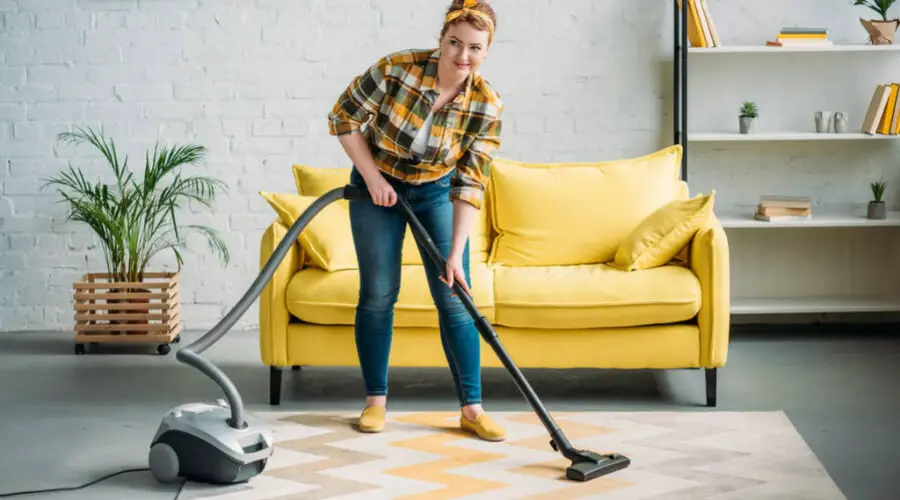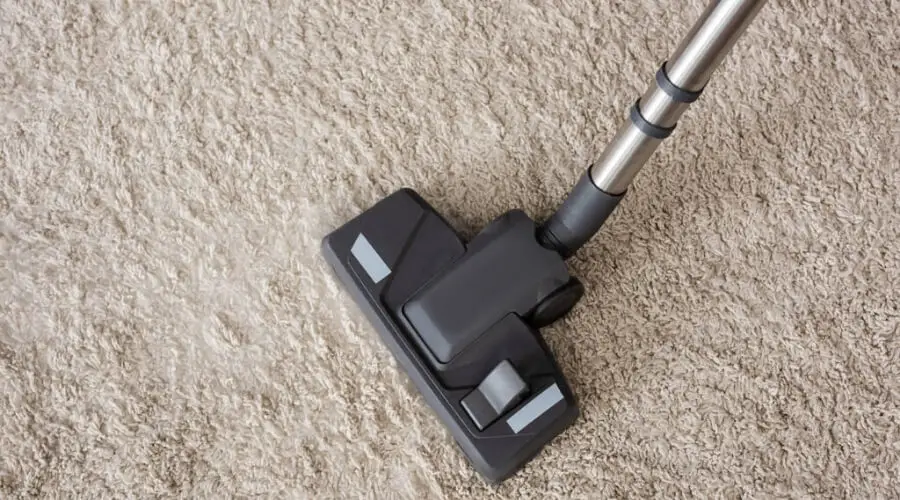Last Updated on July 23, 2023 By Emma W. Thomas
Yes, it is advisable to vacuum after carpet cleaning. Vacuuming helps to remove any remaining debris or dirt that may have been loosened during the cleaning process. This ensures a more thorough and effective cleaning, leaving the carpet looking and feeling fresh.
Should I Vacuum My Carpet After It Is Professionally Cleaned?
Vacuuming a carpet post professional cleaning can be a debatable subject. Let us walk you through some key points in order to provide a clearer picture.
1. The Purpose of Vacuuming after Professional Cleaning:
- To Remove Residual Dirt: Even after professional cleaning, some small particles of dust and dirt might remain trapped within the carpet fibers.
- To Maintain the Fresh Look: Vacuuming helps fluff up the fibers and maintain the clean and fresh appearance of the carpet post-professional cleaning.
2. Professional Cleaning Should be Thorough:
Any professional carpet cleaning service worth its salt should completely remove all traces of dirt, dust, and stains from the carpet. Therefore, theoretically:
- No Requirement for Vacuuming: If thoroughly cleaned, there should technically be no need for vacuuming post-professional cleaning.
- Ask your Professional Cleaner: It is advisable to ask the cleaners directly whether post-cleaning vacuuming is required for your carpet type.
3. Drying Time Factors:
Depending upon the method of professional carpet cleaning adopted — steam cleaning or dry cleaning — the drying time varies.
- Steam Cleaning: This method leaves the carpet damp, and vacuuming it immediately might not be effective.
- Dry Cleaning: After dry cleaning, carpets tend to dry fast. Therefore, you may vacuum sooner.
Comparison Table:
| Cleaning Method | Drying Time | Vacuuming Time |
|---|---|---|
| Steam Cleaning | Several Hours to A Day | After Complete Drying |
| Dry Cleaning | A Few Hours | Sooner, Post Drying |
So, it will be an excellent decision to vacuum your carpet after it is professionally cleaned. While professional cleaning can remove deep-seated dirt and stains, vacuuming afterward helps to pick up any residual particles or debris, ensuring a more thorough and longer-lasting clean. It also helps to restore the carpet’s texture and appearance.
What Are The Benefits Of Vacuuming Your Carpet After Cleaning?
While it may not be necessary to vacuum your carpet after professional cleaning, the practice has several benefits, including;
- Vacuuming a dry carpet helps to remove all dirt and makes your carpet last longer.
- It helps to give an excellent finish to the cleaning and makes your carpet look neat and spotless.
- It protects the carpet from everyday wear and tears
What Are The Steps In Vacuuming The Carpet?

Vacuuming your carpet correctly helps improve its appearance and prolong its life regardless of its type. The practice also helps to reduce wear and damage, especially in high-traffic areas. The following simple steps are crucial for effective carpet vacuuming;.’
Remove Clutter And Debris.
Before you vacuum the carpet, make sure that the surface is clear of any debris and clutter. Besides saving on cleaning time, this step will also prevent your machine from clogging up. Debris and other objects can get stuck in the hose attachment or vacuum bag, damaging your tool, and reducing its efficiency.
Use A Suitable Vacuum Cleaner.
Since there are various types of vacuum cleaners for carpets, choosing the right one to suit your needs is necessary. You can use a handheld, upright, or canister model, depending on the type of carpet that you have. Some models have performance capabilities that enable them to remove dirt while containing dust.
You can look for a vacuum cleaner that is CRI (Carpet and Rug Institute) certified for effective vacuuming outcomes. CRI awards a seal of approval for vacuum cleaners that meet its standards for dust containment, soil removal, and carpet appearance retention.
Vacuuming The Carpet
After removing all the dust particles, choosing the right cleaner, and getting the correct adjustments, the next step is to vacuum your carpet. Be sure to begin slowly while vacuuming in strokes between 3 feet and 4 feet in length. You will then need to move to the sides to start the next pass. Make sure that you overlap the strokes slightly. Doing this will ensure that you vacuum all areas without leaving any debris behind.
When the vacuum bag or canister is full, be sure to empty it. A full canister reduces the efficiency of your cleaner due to the decrease in suction power. Make sure that it does not go beyond 3/4-full.
Vacuum Frequently
You need to vacuum your carpet as often as possible to keep it looking good. Depending on how many activities are in your home, you can clean the carpet once per week. But, if there are pets and heavy traffic, you can vacuum your carpet more times.
How Can You Dry Your Carpet Fast After Cleaning?

Whether you clean it yourself or have a professional do it for you, your carpet gets wet after cleaning. Depending on the humidity and the time of the year, it can take between six and ten hours, but some rugs can go up to 24 hours before drying completely. The following methods can help quicken the drying process of your carpet;
Using A Fan
Your ceiling fan may come in handy in drying your carpet, especially if the mat is placed directly below it. If the outside weather is not ideal for drying your mat, you can switch on your ceiling fan to help create a funnel of air. Using a ceiling fan to dry a carpet helps prevent musty smells as it will circulate air properly.
You may also use a desk or standing fan if you don’t have a ceiling fan, but they won’t work the same way. You may, however, place two small fans at the sides of your mat to help circulate enough air.
Generating Airflow
You can also create enough airflow in your room to help dry the carpet. Open all the room windows where the carpet is to let in adequate, fresh air. Opening the windows helps to prevent any damp, musty smells from the building. If the windows in your room are on two opposite sides, you can open one slightly and the other one fully.
Doing this helps to generate a strong wind that dries your carpet faster. But, the effectiveness of this method depends on the weather. It is cloudy or rainy; this method may end up creating more humidity in the room, which will lead to a musty smell on your carpet.
Using An Air-conditioner
An air-conditioning unit can also come in handy when it comes to drying your carpet quickly. While this technique is not as effective as a fan, you can use it during rainy, humid days. The AC unit will not generate sufficient air, but it can be an alternative to a fan.
Using an air conditioner may take longer to dry your carpet since it creates cold air instead of warm. You may not also know whether the carpet is dry or not as the cold air from your AC unit will react with the damp carpet’s fabric. When your carpet begins feeling dry, switch off the air-conditioning unit.
Towel-drying Your Carpet
You can also use towels to dry your carpet since they are made of absorbent materials. However, this process may require some physical effort since you will have to walk back and forth on the towels. Continue walking over the towels until they become wet. If need be, replace the towels and move them to different areas of the carpet. If you notice that the carpet is dry, check underneath to be sure that no wetness remains.
Conclusion
It is necessary to vacuum your carpet after cleaning to remove any debris stuck deep in the fabrics. The process also helps improve the carpet’s appearance by removing any marks left by the cleaner. But, it is necessary to follow the right steps mentioned in this article to ensure that all the dirt particles and debris are removed and give your carpet a lasting solution.
References:
https://preferredcarpetcare.com/after-the-cleaning/
https://www.getcarpetcleaningorlando.com/blog/carpet-cleaning/do-you-vacuum-after-carpet-cleaning/
Emma is a graduate of Domestic Science or Family and Consumer Sciences (Home Economics) from the University of Wisconsin. She has 7 years of experience Working with the strategic section of BestBuy and now writing full-time for Homeeon.
From Managing the Home, Interiors, Cleaning, and Exteriors to Gardening and everything about Making A Home Liveable – is her passion and this Homeeon is the result of this.
Emma loves decorating her home with the best stuff found online. She cares about quality over anything and writes reviews about them here in Homeeon. Get in touch with her over Pinterest.
Keep reading her blogs.

